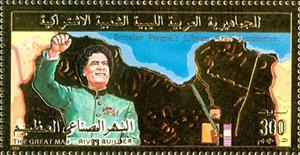Stamp: Irrigation project (Libya 1984)
Irrigation project (Libya 1984)
01 February (Libya ) within release Irrigation project goes into circulation Stamp Irrigation project face value 300 Libyan dirham
| Stamp Irrigation project in catalogues | |
|---|---|
| Michel: | Mi: LY 1279 |
Stamp is square format.
Also in the issue Irrigation project:
- Stamp - Palm tree and Dromedar face value 50;
- Stamp - Fruits and water pipeline face value 50;
- Stamp - Ghaddafi and water pipeline face value 100;
- Souvenir Sheet - Khadafy, map. face value 300;
- Se-tenant - Irrigation project face value 200;
- Stamp - Khadafy, map. face value 100;
- Stamp - Irrigation project face value 300;
Stamp Irrigation project it reflects the thematic directions:
A dictator is a political leader who possesses absolute power. A dictatorship is a state ruled by one dictator or by a polity. The word originated as the title of a Roman dictator elected by the Roman Senate to rule the republic in times of emergency. Like the terms "tyrant" and "autocrat", dictator came to be used almost exclusively as a non-titular term for oppressive rule. In modern usage, the term dictator is generally used to describe a leader who holds or abuses an extraordinary amount of personal power.
A head of state (or chief of state) is the public persona that officially represents the national unity and legitimacy of a sovereign state. In some countries, the head of state is a ceremonial figurehead with limited or no executive power, while in others, the head of state is also the head of government. In countries with parliamentary governments, the head of state is typically a ceremonial figurehead that does not actually guide day-to-day government activities and may not be empowered to exercise any kind of secular political authority (e.g., Queen Elizabeth II as Head of the Commonwealth). In countries where the head of state is also the head of government, the president serves as both a public figurehead and the actual highest ranking political leader who oversees the executive branch (e.g., the President of the United States).
A map is a symbolic depiction emphasizing relationships between elements of some space, such as objects, regions, or themes. Many maps are static, fixed to paper or some other durable medium, while others are dynamic or interactive. Although most commonly used to depict geography, maps may represent any space, real or imagined, without regard to context or scale, such as in brain mapping, DNA mapping, or computer network topology mapping. The space being mapped may be two dimensional, such as the surface of the earth, three dimensional, such as the interior of the earth, or even more abstract spaces of any dimension, such as arise in modeling phenomena having many independent variables. Although the earliest maps known are of the heavens, geographic maps of territory have a very long tradition and exist from ancient times. The word "map" comes from the medieval Latin Mappa mundi, wherein mappa meant napkin or cloth and mundi the world. Thus, "map" became the shortened term referring to a two-dimensional representation of the surface of the world.


